2014 NISSAN QUEST towing
[x] Cancel search: towingPage 465 of 482
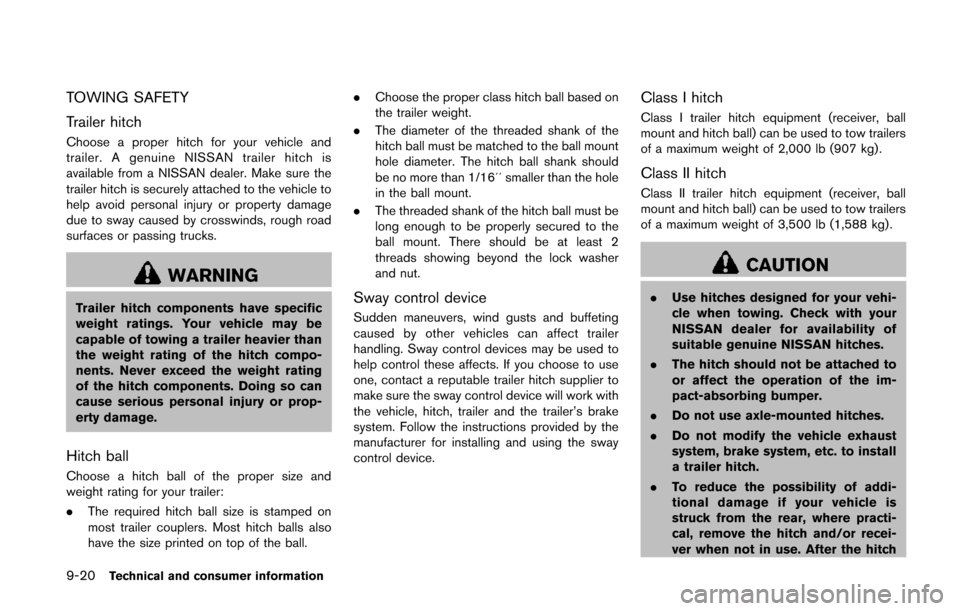
9-20Technical and consumer information
TOWING SAFETY
Trailer hitch
Choose a proper hitch for your vehicle and
trailer. A genuine NISSAN trailer hitch is
available from a NISSAN dealer. Make sure the
trailer hitch is securely attached to the vehicle to
help avoid personal injury or property damage
due to sway caused by crosswinds, rough road
surfaces or passing trucks.
WARNING
Trailer hitch components have specific
weight ratings. Your vehicle may be
capable of towing a trailer heavier than
the weight rating of the hitch compo-
nents. Never exceed the weight rating
of the hitch components. Doing so can
cause serious personal injury or prop-
erty damage.
Hitch ball
Choose a hitch ball of the proper size and
weight rating for your trailer:
.The required hitch ball size is stamped on
most trailer couplers. Most hitch balls also
have the size printed on top of the ball. .
Choose the proper class hitch ball based on
the trailer weight.
. The diameter of the threaded shank of the
hitch ball must be matched to the ball mount
hole diameter. The hitch ball shank should
be no more than 1/16´´ smaller than the hole
in the ball mount.
. The threaded shank of the hitch ball must be
long enough to be properly secured to the
ball mount. There should be at least 2
threads showing beyond the lock washer
and nut.
Sway control device
Sudden maneuvers, wind gusts and buffeting
caused by other vehicles can affect trailer
handling. Sway control devices may be used to
help control these affects. If you choose to use
one, contact a reputable trailer hitch supplier to
make sure the sway control device will work with
the vehicle, hitch, trailer and the trailer’s brake
system. Follow the instructions provided by the
manufacturer for installing and using the sway
control device.
Class I hitch
Class I trailer hitch equipment (receiver, ball
mount and hitch ball) can be used to tow trailers
of a maximum weight of 2,000 lb (907 kg) .
Class II hitch
Class II trailer hitch equipment (receiver, ball
mount and hitch ball) can be used to tow trailers
of a maximum weight of 3,500 lb (1,588 kg).
CAUTION
.Use hitches designed for your vehi-
cle when towing. Check with your
NISSAN dealer for availability of
suitable genuine NISSAN hitches.
. The hitch should not be attached to
or affect the operation of the im-
pact-absorbing bumper.
. Do not use axle-mounted hitches.
. Do not modify the vehicle exhaust
system, brake system, etc. to install
a trailer hitch.
. To reduce the possibility of addi-
tional damage if your vehicle is
struck from the rear, where practi-
cal, remove the hitch and/or recei-
ver when not in use. After the hitch
Page 466 of 482
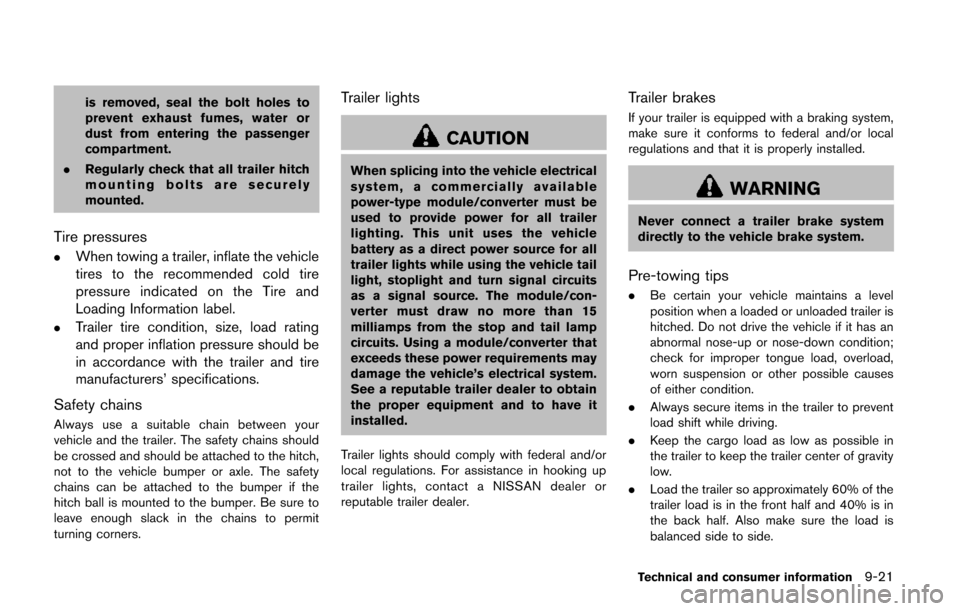
is removed, seal the bolt holes to
prevent exhaust fumes, water or
dust from entering the passenger
compartment.
. Regularly check that all trailer hitch
mounting bolts are securely
mounted.
Tire pressures
.When towing a trailer, inflate the vehicle
tires to the recommended cold tire
pressure indicated on the Tire and
Loading Information label.
.Trailer tire condition, size, load rating
and proper inflation pressure should be
in accordance with the trailer and tire
manufacturers’ specifications.
Safety chains
Always use a suitable chain between your
vehicle and the trailer. The safety chains should
be crossed and should be attached to the hitch,
not to the vehicle bumper or axle. The safety
chains can be attached to the bumper if the
hitch ball is mounted to the bumper. Be sure to
leave enough slack in the chains to permit
turning corners.
Trailer lights
CAUTION
When splicing into the vehicle electrical
system, a commercially available
power-type module/converter must be
used to provide power for all trailer
lighting. This unit uses the vehicle
battery as a direct power source for all
trailer lights while using the vehicle tail
light, stoplight and turn signal circuits
as a signal source. The module/con-
verter must draw no more than 15
milliamps from the stop and tail lamp
circuits. Using a module/converter that
exceeds these power requirements may
damage the vehicle’s electrical system.
See a reputable trailer dealer to obtain
the proper equipment and to have it
installed.
Trailer lights should comply with federal and/or
local regulations. For assistance in hooking up
trailer lights, contact a NISSAN dealer or
reputable trailer dealer.
Trailer brakes
If your trailer is equipped with a braking system,
make sure it conforms to federal and/or local
regulations and that it is properly installed.
WARNING
Never connect a trailer brake system
directly to the vehicle brake system.
Pre-towing tips
. Be certain your vehicle maintains a level
position when a loaded or unloaded trailer is
hitched. Do not drive the vehicle if it has an
abnormal nose-up or nose-down condition;
check for improper tongue load, overload,
worn suspension or other possible causes
of either condition.
. Always secure items in the trailer to prevent
load shift while driving.
. Keep the cargo load as low as possible in
the trailer to keep the trailer center of gravity
low.
. Load the trailer so approximately 60% of the
trailer load is in the front half and 40% is in
the back half. Also make sure the load is
balanced side to side.
Technical and consumer information9-21
Page 467 of 482
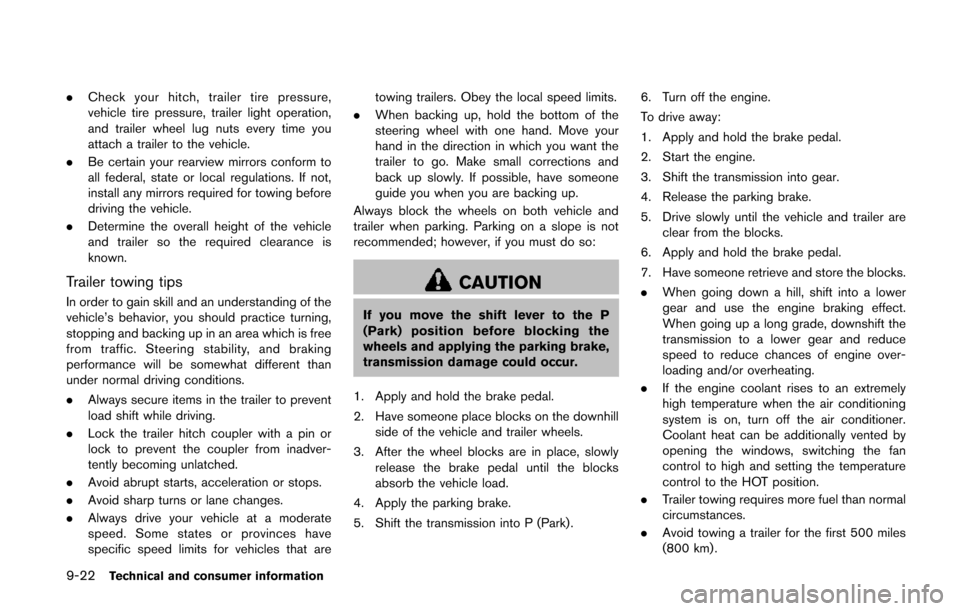
9-22Technical and consumer information
.Check your hitch, trailer tire pressure,
vehicle tire pressure, trailer light operation,
and trailer wheel lug nuts every time you
attach a trailer to the vehicle.
. Be certain your rearview mirrors conform to
all federal, state or local regulations. If not,
install any mirrors required for towing before
driving the vehicle.
. Determine the overall height of the vehicle
and trailer so the required clearance is
known.
Trailer towing tips
In order to gain skill and an understanding of the
vehicle’s behavior, you should practice turning,
stopping and backing up in an area which is free
from traffic. Steering stability, and braking
performance will be somewhat different than
under normal driving conditions.
.Always secure items in the trailer to prevent
load shift while driving.
. Lock the trailer hitch coupler with a pin or
lock to prevent the coupler from inadver-
tently becoming unlatched.
. Avoid abrupt starts, acceleration or stops.
. Avoid sharp turns or lane changes.
. Always drive your vehicle at a moderate
speed. Some states or provinces have
specific speed limits for vehicles that are towing trailers. Obey the local speed limits.
. When backing up, hold the bottom of the
steering wheel with one hand. Move your
hand in the direction in which you want the
trailer to go. Make small corrections and
back up slowly. If possible, have someone
guide you when you are backing up.
Always block the wheels on both vehicle and
trailer when parking. Parking on a slope is not
recommended; however, if you must do so:
CAUTION
If you move the shift lever to the P
(Park) position before blocking the
wheels and applying the parking brake,
transmission damage could occur.
1. Apply and hold the brake pedal.
2. Have someone place blocks on the downhill side of the vehicle and trailer wheels.
3. After the wheel blocks are in place, slowly release the brake pedal until the blocks
absorb the vehicle load.
4. Apply the parking brake.
5. Shift the transmission into P (Park) . 6. Turn off the engine.
To drive away:
1. Apply and hold the brake pedal.
2. Start the engine.
3. Shift the transmission into gear.
4. Release the parking brake.
5. Drive slowly until the vehicle and trailer are
clear from the blocks.
6. Apply and hold the brake pedal.
7. Have someone retrieve and store the blocks.
. When going down a hill, shift into a lower
gear and use the engine braking effect.
When going up a long grade, downshift the
transmission to a lower gear and reduce
speed to reduce chances of engine over-
loading and/or overheating.
. If the engine coolant rises to an extremely
high temperature when the air conditioning
system is on, turn off the air conditioner.
Coolant heat can be additionally vented by
opening the windows, switching the fan
control to high and setting the temperature
control to the HOT position.
. Trailer towing requires more fuel than normal
circumstances.
. Avoid towing a trailer for the first 500 miles
(800 km) .
Page 468 of 482
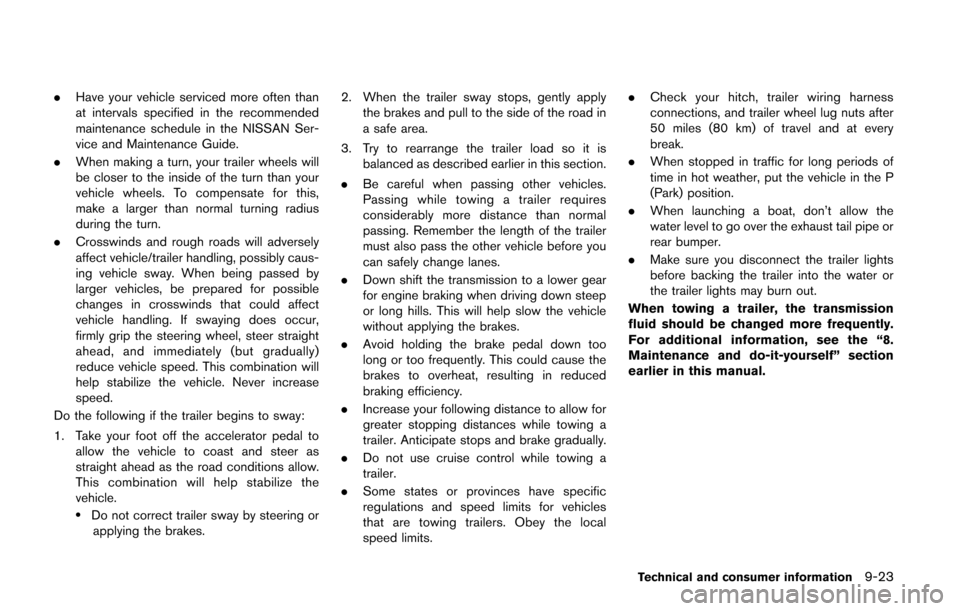
.Have your vehicle serviced more often than
at intervals specified in the recommended
maintenance schedule in the NISSAN Ser-
vice and Maintenance Guide.
. When making a turn, your trailer wheels will
be closer to the inside of the turn than your
vehicle wheels. To compensate for this,
make a larger than normal turning radius
during the turn.
. Crosswinds and rough roads will adversely
affect vehicle/trailer handling, possibly caus-
ing vehicle sway. When being passed by
larger vehicles, be prepared for possible
changes in crosswinds that could affect
vehicle handling. If swaying does occur,
firmly grip the steering wheel, steer straight
ahead, and immediately (but gradually)
reduce vehicle speed. This combination will
help stabilize the vehicle. Never increase
speed.
Do the following if the trailer begins to sway:
1. Take your foot off the accelerator pedal to allow the vehicle to coast and steer as
straight ahead as the road conditions allow.
This combination will help stabilize the
vehicle.
.Do not correct trailer sway by steering orapplying the brakes. 2. When the trailer sway stops, gently apply
the brakes and pull to the side of the road in
a safe area.
3. Try to rearrange the trailer load so it is balanced as described earlier in this section.
. Be careful when passing other vehicles.
Passing while towing a trailer requires
considerably more distance than normal
passing. Remember the length of the trailer
must also pass the other vehicle before you
can safely change lanes.
. Down shift the transmission to a lower gear
for engine braking when driving down steep
or long hills. This will help slow the vehicle
without applying the brakes.
. Avoid holding the brake pedal down too
long or too frequently. This could cause the
brakes to overheat, resulting in reduced
braking efficiency.
. Increase your following distance to allow for
greater stopping distances while towing a
trailer. Anticipate stops and brake gradually.
. Do not use cruise control while towing a
trailer.
. Some states or provinces have specific
regulations and speed limits for vehicles
that are towing trailers. Obey the local
speed limits. .
Check your hitch, trailer wiring harness
connections, and trailer wheel lug nuts after
50 miles (80 km) of travel and at every
break.
. When stopped in traffic for long periods of
time in hot weather, put the vehicle in the P
(Park) position.
. When launching a boat, don’t allow the
water level to go over the exhaust tail pipe or
rear bumper.
. Make sure you disconnect the trailer lights
before backing the trailer into the water or
the trailer lights may burn out.
When towing a trailer, the transmission
fluid should be changed more frequently.
For additional information, see the “8.
Maintenance and do-it-yourself” section
earlier in this manual.
Technical and consumer information9-23
Page 469 of 482
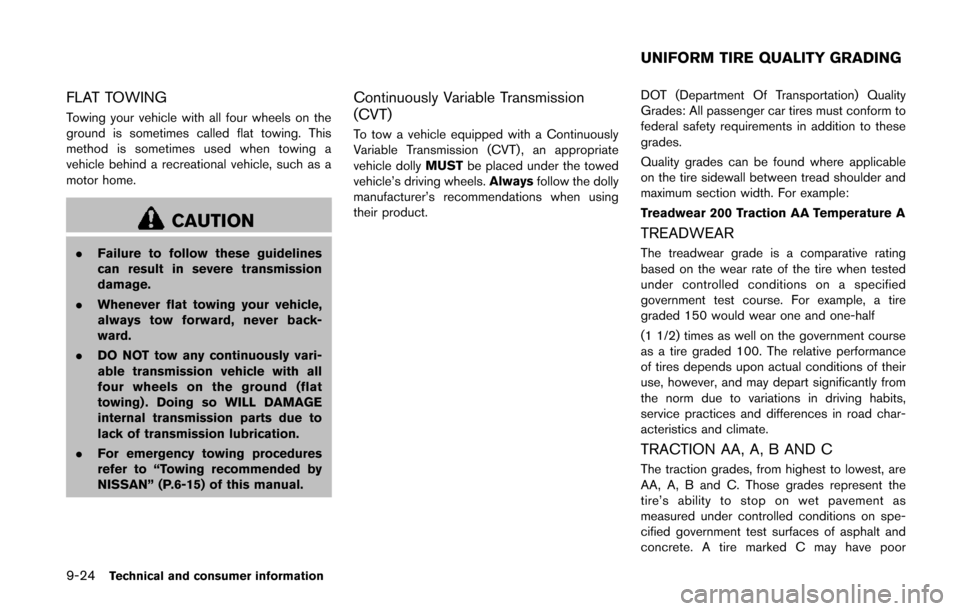
9-24Technical and consumer information
FLAT TOWING
Towing your vehicle with all four wheels on the
ground is sometimes called flat towing. This
method is sometimes used when towing a
vehicle behind a recreational vehicle, such as a
motor home.
CAUTION
.Failure to follow these guidelines
can result in severe transmission
damage.
. Whenever flat towing your vehicle,
always tow forward, never back-
ward.
. DO NOT tow any continuously vari-
able transmission vehicle with all
four wheels on the ground (flat
towing) . Doing so WILL DAMAGE
internal transmission parts due to
lack of transmission lubrication.
. For emergency towing procedures
refer to “Towing recommended by
NISSAN” (P.6-15) of this manual.
Continuously Variable Transmission
(CVT)
To tow a vehicle equipped with a Continuously
Variable Transmission (CVT) , an appropriate
vehicle dolly MUSTbe placed under the towed
vehicle’s driving wheels. Alwaysfollow the dolly
manufacturer’s recommendations when using
their product. DOT (Department Of Transportation) Quality
Grades: All passenger car tires must conform to
federal safety requirements in addition to these
grades.
Quality grades can be found where applicable
on the tire sidewall between tread shoulder and
maximum section width. For example:
Treadwear 200 Traction AA Temperature A
TREADWEAR
The treadwear grade is a comparative rating
based on the wear rate of the tire when tested
under controlled conditions on a specified
government test course. For example, a tire
graded 150 would wear one and one-half
(1 1/2) times as well on the government course
as a tire graded 100. The relative performance
of tires depends upon actual conditions of their
use, however, and may depart significantly from
the norm due to variations in driving habits,
service practices and differences in road char-
acteristics and climate.
TRACTION AA, A, B AND C
The traction grades, from highest to lowest, are
AA, A, B and C. Those grades represent the
tire’s ability to stop on wet pavement as
measured under controlled conditions on spe-
cified government test surfaces of asphalt and
concrete. A tire marked C may have poor
UNIFORM TIRE QUALITY GRADING
Page 475 of 482
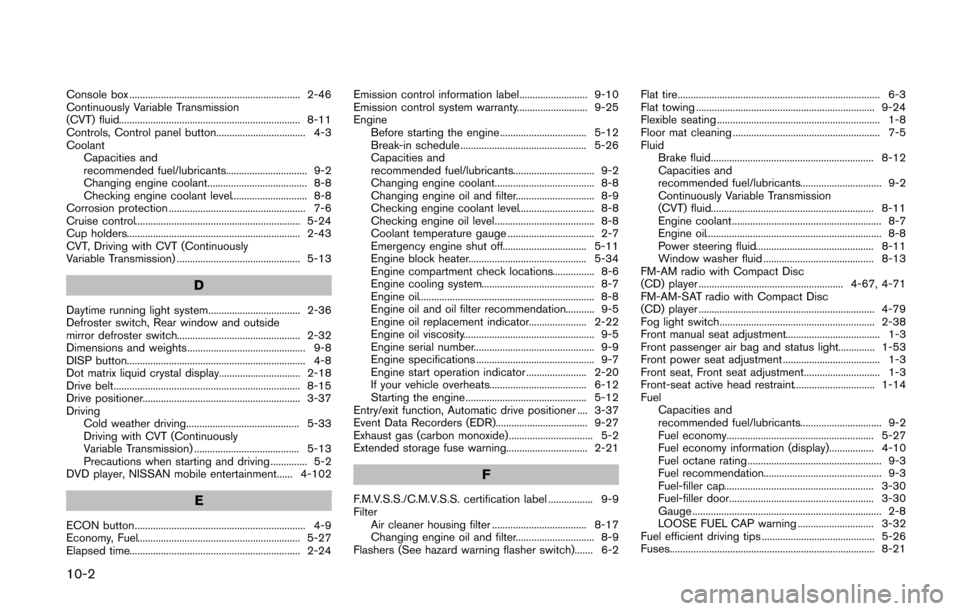
10-2
Console box ................................................................. 2-46
Continuously Variable Transmission
(CVT) fluid..................................................................... 8-11
Controls, Control panel button.................................. 4-3
Coolant Capacities and
recommended fuel/lubricants............................... 9-2
Changing engine coolant...................................... 8-8
Checking engine coolant level............................. 8-8
Corrosion protection .................................................... 7-6
Cruise control............................................................... 5-24
Cup holders.................................................................. 2-43
CVT, Driving with CVT (Continuously
Variable Transmission) ............................................... 5-13
D
Daytime running light system................................... 2-36
Defroster switch, Rear window and outside
mirror defroster switch............................................... 2-32
Dimensions and weights............................................. 9-8
DISP button.................................................................... 4-8
Dot matrix liquid crystal display............................... 2-18
Drive belt....................................................................... 8-15
Drive positioner............................................................ 3-37
Driving Cold weather driving........................................... 5-33
Driving with CVT (Continuously
Variable Transmission) ........................................ 5-13
Precautions when starting and driving .............. 5-2
DVD player, NISSAN mobile entertainment...... 4-102
E
ECON button................................................................. 4-9
Economy, Fuel.............................................................. 5-27
Elapsed time................................................................. 2-24 Emission control information label.......................... 9-10
Emission control system warranty........................... 9-25
Engine Before starting the engine................................. 5-12
Break-in schedule ................................................ 5-26
Capacities and
recommended fuel/lubricants............................... 9-2
Changing engine coolant...................................... 8-8
Changing engine oil and filter.............................. 8-9
Checking engine coolant level............................. 8-8
Checking engine oil level...................................... 8-8
Coolant temperature gauge ................................. 2-7
Emergency engine shut off................................ 5-11
Engine block heater............................................. 5-34
Engine compartment check locations................ 8-6
Engine cooling system........................................... 8-7
Engine oil................................................................... 8-8
Engine oil and oil filter recommendation........... 9-5
Engine oil replacement indicator...................... 2-22
Engine oil viscosity.................................................. 9-5
Engine serial number.............................................. 9-9
Engine specifications ............................................. 9-7
Engine start operation indicator ....................... 2-20
If your vehicle overheats..................................... 6-12
Starting the engine .............................................. 5-12
Entry/exit function, Automatic drive positioner .... 3-37
Event Data Recorders (EDR)................................... 9-27
Exhaust gas (carbon monoxide)................................ 5-2
Extended storage fuse warning............................... 2-21
F
F.M.V.S.S./C.M.V.S.S. certification label ................. 9-9
Filter Air cleaner housing filter .................................... 8-17
Changing engine oil and filter.............................. 8-9
Flashers (See hazard warning flasher switch)....... 6-2 Flat tire............................................................................. 6-3
Flat towing .................................................................... 9-24
Flexible seating .............................................................. 1-8
Floor mat cleaning ........................................................ 7-5
Fluid Brake fluid.............................................................. 8-12
Capacities and
recommended fuel/lubricants............................... 9-2
Continuously Variable Transmission
(CVT) fluid.............................................................. 8-11
Engine coolant......................................................... 8-7
Engine oil................................................................... 8-8
Power steering fluid............................................. 8-11
Window washer fluid .......................................... 8-13
FM-AM radio with Compact Disc
(CD) player ....................................................... 4-67, 4-71
FM-AM-SAT radio with Compact Disc
(CD) player ................................................................... 4-79
Fog light switch........................................................... 2-38
Front manual seat adjustment.................................... 1-3
Front passenger air bag and status light.............. 1-53
Front power seat adjustment ..................................... 1-3
Front seat, Front seat adjustment............................. 1-3
Front-seat active head restraint............................... 1-14
Fuel Capacities and
recommended fuel/lubricants............................... 9-2
Fuel economy........................................................ 5-27
Fuel economy information (display)................. 4-10
Fuel octane rating ................................................... 9-3
Fuel recommendation............................................. 9-3
Fuel-filler cap......................................................... 3-30
Fuel-filler door....................................................... 3-30
Gauge ........................................................................ 2-8
LOOSE FUEL CAP warning ............................. 3-32
Fuel efficient driving tips ........................................... 5-26
Fuses.............................................................................. 8-21
Page 478 of 482

FM-AM radio with Compact Disc
(CD) player ............................................................ 4-71
FM-AM-SAT radio with Compact Disc
(CD) player ............................................................ 4-79
Rapid air pressure loss................................................ 5-7
Readiness for inspection/maintenance
(I/M) test........................................................................ 9-27
Rear personal lights.................................................... 2-56
Rear window and outside mirror
defroster switch........................................................... 2-32
Rear window wiper and washer switch ................ 2-31
Rearview monitor......................................................... 4-23
Recorders, Event data ............................................... 9-27
Registering your vehicle in another country........... 9-8
Remote controller (DVD) ....................................... 4-112
Remote keyless entry system................................... 3-21
Reporting safety defects (US only)........................ 9-26
Rollover............................................................................ 5-6
Roof, Roof rack............................................................ 2-49
S
Safety Child seat belts .................................................... 1-24
Reporting safety defects (US only)................. 9-26
Towing safety......................................................... 9-20
Satellite radio operation ............................................ 4-80
Seat adjustment Front manual seat adjustment.............................. 1-3
Front power seat adjustment ............................... 1-3
Front seats................................................................ 1-3
Seat belt(s) Child safety............................................................ 1-24
Infants...................................................................... 1-25
Injured persons..................................................... 1-17
Larger children...................................................... 1-26
Precautions on seat belt usage........................ 1-15 Pregnant women .................................................. 1-17
Seat belt cleaning................................................... 7-6
Seat belt extenders.............................................. 1-23
Seat belt hooks .................................................... 1-23
Seat belt maintenance........................................ 1-24
Seat belt warning light and chime................... 2-15
Seat belts............................................................... 1-15
Seat belts with pretensioners........................... 1-58
Shoulder belt height adjustment...................... 1-23
Small children........................................................ 1-25
Three-point type................................................... 1-17
Seat(s) Driver-side memory.............................................. 3-37
Heated seats......................................................... 2-38
Seats .......................................................................... 1-2
Security system (NISSAN Vehicle Immobilizer
System) , Engine start................................................. 2-29
Security system, Vehicle security system ............. 2-28
Servicing air conditioner............................................ 4-52
SETTING button.......................................................... 4-13
Shift lever Shift lock release.................................................. 5-16
Shift lock release, Transmission .............................. 5-16
Shifting, CVT (Continuously
Variable Transmission) ............................................... 5-13
Shoulder belt height adjustment............................. 1-23
Sliding doors.................................................................. 3-7
SOURCE select switch.......................................... 4-101
Spare tire.............................................................. 8-39, 9-7
Spark plugs .................................................................. 8-16
Speedometer.................................................................. 2-6
Starting Before starting the engine................................. 5-12
Jump starting......................................................... 6-10
Precautions when starting and driving .............. 5-2
Push starting ......................................................... 6-12
Starting the engine .............................................. 5-12 STATUS button.............................................................. 4-8
Status light, Front passenger air bag .................... 1-53
Steering
Power steering fluid............................................. 8-11
Steering-wheel-mounted controls
for audio ............................................................... 4-100
Tilt/telescopic steering........................................ 3-32
Storage .......................................................................... 2-43
Sun visors ..................................................................... 3-33
Sunglasses holder ...................................................... 2-45
Supplemental air bag warning labels..................... 1-59
Supplemental air bag warning light............ 1-59, 2-15
Supplemental restraint system................................. 1-46 Precautions on supplemental
restraint system..................................................... 1-46
Switch Autolight switch.................................................... 2-34
Fog light switch.................................................... 2-38
Hazard warning flasher switch............................. 6-2
Headlight aiming control .................................... 2-36
Headlight switch................................................... 2-33
Overdrive OFF switch......................................... 5-15
Power door lock switch......................................... 3-6
Rear window and outside mirror
defroster switch.................................................... 2-32
Turn signal switch ................................................ 2-37
Vehicle dynamic control (VDC) off switch..... 2-40
T
Tachometer ..................................................................... 2-7
Temperature display.................................................... 2-25
Temperature gauge, Engine coolant
temperature gauge........................................................ 2-7
Theft (NISSAN Vehicle Immobilizer System) ,
Engine start................................................................... 2-29
Three-way catalyst........................................................ 5-3
10-5
Page 479 of 482
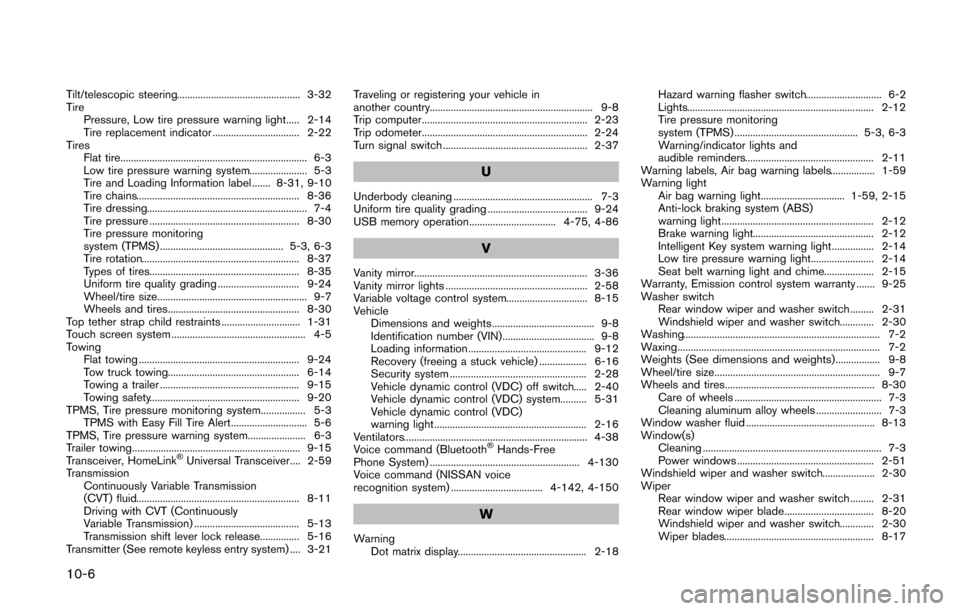
10-6
Tilt/telescopic steering............................................... 3-32
TirePressure, Low tire pressure warning light..... 2-14
Tire replacement indicator ................................. 2-22
Tires Flat tire....................................................................... 6-3
Low tire pressure warning system...................... 5-3
Tire and Loading Information label ....... 8-31, 9-10
Tire chains.............................................................. 8-36
Tire dressing............................................................. 7-4
Tire pressure ......................................................... 8-30
Tire pressure monitoring
system (TPMS) ............................................... 5-3, 6-3
Tire rotation............................................................ 8-37
Types of tires......................................................... 8-35
Uniform tire quality grading ............................... 9-24
Wheel/tire size......................................................... 9-7
Wheels and tires.................................................. 8-30
Top tether strap child restraints .............................. 1-31
Touch screen system ................................................... 4-5
Towing Flat towing ............................................................. 9-24
Tow truck towing.................................................. 6-14
Towing a trailer ..................................................... 9-15
Towing safety......................................................... 9-20
TPMS, Tire pressure monitoring system................. 5-3 TPMS with Easy Fill Tire Alert............................. 5-6
TPMS, Tire pressure warning system...................... 6-3
Trailer towing................................................................ 9-15
Transceiver, HomeLink
®Universal Transceiver.... 2-59
Transmission Continuously Variable Transmission
(CVT) fluid.............................................................. 8-11
Driving with CVT (Continuously
Variable Transmission) ........................................ 5-13
Transmission shift lever lock release............... 5-16
Transmitter (See remote keyless entry system) .... 3-21 Traveling or registering your vehicle in
another country.............................................................. 9-8
Trip computer............................................................... 2-23
Trip odometer............................................................... 2-24
Turn signal switch ....................................................... 2-37
U
Underbody cleaning ..................................................... 7-3
Uniform tire quality grading ...................................... 9-24
USB memory operation................................. 4-75, 4-86
V
Vanity mirror.................................................................. 3-36
Vanity mirror lights ...................................................... 2-58
Variable voltage control system............................... 8-15
Vehicle Dimensions and weights....................................... 9-8
Identification number (VIN)................................... 9-8
Loading information ............................................. 9-12
Recovery (freeing a stuck vehicle) .................. 6-16
Security system .................................................... 2-28
Vehicle dynamic control (VDC) off switch..... 2-40
Vehicle dynamic control (VDC) system.......... 5-31
Vehicle dynamic control (VDC)
warning light.......................................................... 2-16
Ventilators...................................................................... 4-38
Voice command (Bluetooth
®Hands-Free
Phone System) ......................................................... 4-130
Voice command (NISSAN voice
recognition system) ................................... 4-142, 4-150
W
Warning Dot matrix display................................................. 2-18 Hazard warning flasher switch............................. 6-2
Lights....................................................................... 2-12
Tire pressure monitoring
system (TPMS) ............................................... 5-3, 6-3
Warning/indicator lights and
audible reminders................................................. 2-11
Warning labels, Air bag warning labels................. 1-59
Warning light Air bag warning light................................ 1-59, 2-15
Anti-lock braking system (ABS)
warning light.......................................................... 2-12
Brake warning light.............................................. 2-12
Intelligent Key system warning light................ 2-14
Low tire pressure warning light........................ 2-14
Seat belt warning light and chime................... 2-15
Warranty, Emission control system warranty ....... 9-25
Washer switch Rear window wiper and washer switch ......... 2-31
Windshield wiper and washer switch............. 2-30
Washing........................................................................... 7-2
Waxing............................................................................. 7-2
Weights (See dimensions and weights)................. 9-8
Wheel/tire size............................................................... 9-7
Wheels and tires......................................................... 8-30 Care of wheels ........................................................ 7-3
Cleaning aluminum alloy wheels ......................... 7-3
Window washer fluid ................................................. 8-13
Window(s) Cleaning .................................................................... 7-3
Power windows .................................................... 2-51
Windshield wiper and washer switch.................... 2-30
Wiper Rear window wiper and washer switch ......... 2-31
Rear window wiper blade.................................. 8-20
Windshield wiper and washer switch............. 2-30
Wiper blades......................................................... 8-17